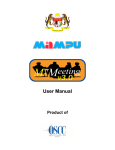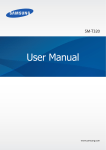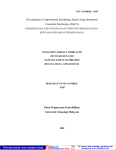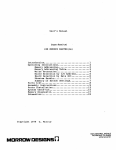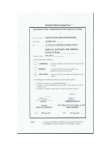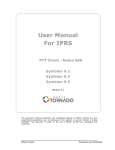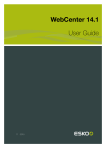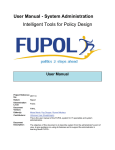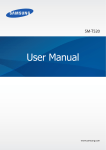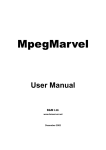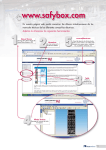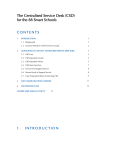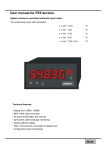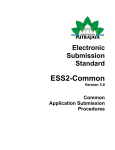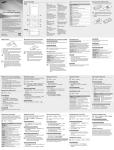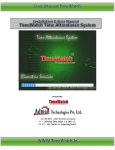Download User Manual 2.2
Transcript
User Manual 2.2
Product
MyMeeting Version 2.2
1
Table of Contents
1 Welcome to MyMeeting ..................................................................................................................1
1.1 Introduction................................................................................................................................1
1.2 Benefits of MyMeeting...............................................................................................................1
1.3 Objectives of MyMeeting............................................................................................................2
1.4 System Flow..............................................................................................................................2
1.4.1 Committee..........................................................................................................................3
1.4.2 Users..................................................................................................................................4
1.4.3 Groups................................................................................................................................4
2 Installation.......................................................................................................................................6
2.1 System Requirements................................................................................................................6
2.2 Apache Configuration................................................................................................................6
2.3 Installing MyMeeting..................................................................................................................6
3 Getting Started..............................................................................................................................12
3.1 Introduction..............................................................................................................................12
3.2 General Icons used in MyMeeting............................................................................................12
3.3 Registration..............................................................................................................................13
3.4 Changing Password.................................................................................................................13
3.5 Recovering a Lost Password...................................................................................................13
4 MyMeeting Users...........................................................................................................................15
4.1 Type of Users and Access Permissions ..................................................................................15
4.2 Logging In and Out..................................................................................................................15
4.3 My Committees........................................................................................................................17
4.4 My Profile.................................................................................................................................17
5 Accessing MyMeeting: Users / Members....................................................................................20
5.1 Introduction..............................................................................................................................20
5.2 Preparation for Meeting............................................................................................................20
5.3 Confirming Attendance............................................................................................................20
5.4 Invitation Emails.......................................................................................................................21
5.5 During Meeting.........................................................................................................................21
5.6 Viewing Minutes and Decisions...............................................................................................21
5.7 Search.....................................................................................................................................24
5.8 Address Book..........................................................................................................................25
5.9 Files Archive............................................................................................................................25
5.10 After MyMeeting.....................................................................................................................25
5.11 User Status............................................................................................................................26
5.11.1 Add User Status..............................................................................................................26
5.11.2 Edit User Status..............................................................................................................27
5.12 Group Status..........................................................................................................................27
5.12.1 Add Group Status...........................................................................................................27
5.12.2 Edit Group Status...........................................................................................................28
5.13 Comment...............................................................................................................................29
5.13.1 Adding Meeting Comments.............................................................................................29
5.13.2 Adding Status Comments...............................................................................................29
5.13.3 Adding Decision Comments............................................................................................30
5.13.4 View History of Status & Comments...............................................................................30
6 Managing MyMeeting : Secretariat /Admin..................................................................................31
6.1 Managing Committees.............................................................................................................31
6.1.1 Edit Committees...............................................................................................................31
MyMeeting Version 2.2
2
6.1.2 Adding Sub-Committees...................................................................................................32
6.1.3 Deleting Committees & Sub-Committees..........................................................................33
6.2 Managing Permissions.............................................................................................................33
6.2.1 Add Permissions...............................................................................................................35
6.2.2 Edit Permissions...............................................................................................................35
6.2.3 View Permissions.............................................................................................................36
6.2.4 Delete Permissions...........................................................................................................36
6.3 Managing Announcement........................................................................................................36
6.3.1 Add Announcement..........................................................................................................36
6.3.2 Edit Announcement..........................................................................................................37
6.3.3 View Announcement.........................................................................................................37
6.3.4 Delete Announcement......................................................................................................38
6.4 Managing Groups....................................................................................................................38
6.4.1 Add Groups......................................................................................................................39
6.4.2 Edit Groups.......................................................................................................................39
6.4.3 View Groups.....................................................................................................................40
6.4.4 Delete Groups...................................................................................................................40
6.5 Managing Committee Users.....................................................................................................40
6.5.1 Add users.........................................................................................................................40
6.5.2 Edit Users.........................................................................................................................42
6.5.3 View Users.......................................................................................................................42
6.5.4 Delete Users.....................................................................................................................42
6.6 Managing Committees Todo....................................................................................................43
6.6.1 Add Todo..........................................................................................................................43
6.6.2 Edit Todo..........................................................................................................................44
6.6.3 View Todo.........................................................................................................................44
6.6.4 Delete Todo......................................................................................................................44
6.7 Managing Message Template..................................................................................................45
6.7.1 Edit Template....................................................................................................................45
6.7.2 View Template..................................................................................................................48
7 Using MyMeeting : Secretariat /Admin........................................................................................49
7.1 Introduction..............................................................................................................................49
7.2 Preparation for Meeting............................................................................................................49
7.3 Projects....................................................................................................................................49
7.3.1 Add Projects.....................................................................................................................50
7.3.2 Edit Projects.....................................................................................................................50
7.3.3 View Projects....................................................................................................................51
7.3.4 Delete Projects.................................................................................................................52
7.4 Meetings..................................................................................................................................52
7.4.1 Add Meetings ...................................................................................................................52
7.4.2 Edit Meetings....................................................................................................................55
7.4.3 View Meetings..................................................................................................................55
7.4.4 Delete Meetings................................................................................................................56
7.5 Meetings Todo.........................................................................................................................57
7.5.1 Add Meeting Todo............................................................................................................57
7.5.2 Edit Meeting Todo.............................................................................................................58
7.5.3 Delete Meeting Todo........................................................................................................58
7.6 During a Meeting......................................................................................................................58
7.7 Attendance...............................................................................................................................58
7.7.1 Taking Attendance............................................................................................................59
MyMeeting Version 2.2
3
7.8 Minutes....................................................................................................................................59
7.8.1 Add Minutes......................................................................................................................60
7.8.2 Edit Minutes......................................................................................................................62
7.9 After Meeting...........................................................................................................................62
7.10 Decisions...............................................................................................................................62
7.10.1 Add Decisions.................................................................................................................63
7.10.2 Edit Decisions.................................................................................................................64
7.10.3 Delete Decisions.............................................................................................................64
7.10.4 Demote or Promote Decisions........................................................................................64
7.10.5 Email & Announce Decisions..........................................................................................64
7.11 View Minutes..........................................................................................................................65
7.12 View Reports..........................................................................................................................65
7.13 View Summary.......................................................................................................................66
8 Accessing MyMeeting : Super Administrator..............................................................................67
8.1 Setting Up Committees............................................................................................................67
8.1.1 Adding Committees..........................................................................................................67
8.2 Managing Roles.......................................................................................................................68
8.2.1 Add Roles.........................................................................................................................68
8.2.2 Edit Roles.........................................................................................................................69
8.2.3 Delete Roles.....................................................................................................................69
8.3 Managing Titles........................................................................................................................69
8.3.1 Add Titles..........................................................................................................................70
8.3.2 Edit Titles..........................................................................................................................71
8.3.3 Delete Titles......................................................................................................................71
8.4 Managing System-wide Users.................................................................................................71
8.4.1 Add Users.........................................................................................................................71
8.4.2 Edit Users.........................................................................................................................72
8.4.3 View Users.......................................................................................................................73
8.4.4 Delete Users.....................................................................................................................73
8.4.5 Reset Users......................................................................................................................74
8.5 Managing System-wide Todo...................................................................................................75
8.5.1 Add Todo..........................................................................................................................75
8.5.2 Edit Todo..........................................................................................................................75
8.5.3 Delete Todo......................................................................................................................76
8.6 Managing System-wide Messages...........................................................................................76
8.6.1 Edit Messages..................................................................................................................76
8.6.2 View Messages.................................................................................................................76
8.7 Managing Global Settings........................................................................................................76
8.7.1 Reload Settings................................................................................................................78
8.7.2 Change Logo....................................................................................................................78
8.8 Managing Logs........................................................................................................................79
8.8.1 Deleting Logs....................................................................................................................79
8.9 Viewing Statistics.....................................................................................................................80
Appendix A : MyMeeting License....................................................................................................81
MyMeeting Version 2.2
4
1 Welcome to MyMeeting
1.1
Introduction
MyMeeting is a web-based paperless meeting decision monitoring and management system. It is a
product of Bahagian Dasar & Perancangan ICT (BDPICT) MAMPU developed in accordance with the
Pekeliling Kemajuan Pentadbiran Awam Bilangan 2 Tahun 1991, Panduan Pengurusan Mesyuarat
dan Urusan Jawatankuasa-jawatankuasa Kerajaan. It started out as a solution to members of
Government IT and Internet Committee (GITIC) and is now a fully-fleged application that has been
further enhanced for implementation by all Malaysian government agencies at various levels.
MyMeeting has won the prestigious Anugerah Inovasi Perkhidmatan Awam (AIPA) Award in
conjunction with the Anugerah Kualiti Sektor Awam (AKSA), which is an event organized by MAMPU
to give recognition and appreciation to Public Sector Agencies.
MyMeeting installation is easy. Once successfully installed, it is accessible by normal web browsers
(eg. Firefox, Internet Explorer, etc).
1.2
Benefits of MyMeeting
MyMeeting is designed for 4 groups of users, namely 'Super Administrators', 'Secretariat/Admin',
'Chairman', and 'Meeting members'. Benefits of MyMeeting includes:
➢For 'Super Administrators'
◦Facilitates system wide administration
◦Monitors usage activities
➢For 'Secretariat/Admin'
◦Facilitates meeting preparation
◦Automatically sends out meeting invitations & alerts
◦Automatically sends out reminders to update status
◦Automatically extracts decision task list from minutes
◦Facilitates minutes & reports preparation through government-approved
➢For 'Chairman'
◦Monitors and gives comments on the status of action
◦Monitors the task handling status
◦Receives notices of status updates
◦Easy retrieval of meeting information and archive
templates
items
➢For 'Meeting members'
◦Updates the task handling status anywhere, anytime
◦Receives automatic reminders to update status
◦Conducts discussions online
◦Updates profile
MyMeeting Version 2.2
1
* The functions for Chairman and Meeting Members have been combined as one, referring to
chapter 4.1 => Accessing MyMeeting : Users / Members
1.3
Objectives of MyMeeting
MyMeeting objectives are as follows :
➢
➢
➢
➢
1.4
Effective monitoring of decisions made in meetings
Elevate the efficiency and better communication among meeting members
Easy information sharing
Workflow automation to ease secretariat workloads
System Flow
Diagram 1: MyMeeting Flow
The diagram above explains the flow in MyMeeting. MyMeeting consists of one or more committees.
The users in MyMeeting belong to one or more committee. Meeting will be held in the committee to
discuss projects and come out with decisions. Action items in decisions will be carried out by the
meeting members in charge, who need to report the action status to the committee.
MyMeeting Version 2.2
2
1.4.1
Committee
Committee
Sub-Committee
Sub-Committee
Sub-Committee
Sub-Committee
Sub-Committee
Sub-Committee
Diagram 2 : Committee Level
Pematuhan ICT
BDPICT
Seksyen Dasar
Sekyen
Pembangunan ICT
Agensi
BPGICT
Sekyen Pusat Data
Seksyen Pengurusan
Rangkaian ICT
Diagram 3 : Example of Committees in MAMPU
In MyMeeting, a committee is a group of people who holds regular meetings to discuss the same
subject matters. A committee can have multiple sub-committees and the sub-committees can also
have another level of sub-committee. One person can belong to many committees as he might be
involved in many meeting discussions. An organization can have many sub-committees as different
sets of people might discuss different aspect of the organization. Lets take a look at a MAMPU's
organization and explore what committees might be created for that organization. The committees for
MAMPU are:
1) Pematuhan ICT: The organization name itself might be a committee. This committee would
consist of every single person in the organization. This committee might not hold meeting very often,
maybe once a month or maybe only once a year.
2) BDPICT: The MAMPU's BDPICT can also have a committee of their own to discuss how
ICT should be planned, developed, maintained, managed, and can help expand services to reach its
goal. This committee might only consist of the Director, Vice Director, Secretary and head of
departments of BDPICT. They might want to meet once a week to discuss the status of the current
implementation and make plans for the future.
3) Seksyen Dasar: BDPICT consists of many sections, and seksyen dasar is one of them.
This section plans, monitors , analyses and evaluates the weakness of ICT network in agencies.
4) Unit Penyelidikan Perancangan ICT: Every section in MAMPU has its own unit which
consists of their own committee to discuss how the unit could contribute to achieve the overall goal of
the organization. So the Unit Penyelidikan Perancangan ICT would have a committee to discuss how
MyMeeting Version 2.2
3
it should carry out its operation. So every other unit will also have their own committees like Unit
Penilaian committee of the Section Pembangunan ICT Agensi, Unit Penyelerasan committee of the
Seksyen Penyelerasan dan Penyebaran Dasar and so on.
Committee/ Sub-Committee
(eg : BDPICT)
Meeting No 2
(eg : Bil 2 Tahun 2009)
Meeting No 1
(eg : Bil 1 Tahun 2009)
Project 1
(eg :Portal eKL)
Project 1
(eg :Gerbang
SMS Kerajaan)
Project 2
(eg :myGov
XChange)
Meeting No 3
(eg : Bil 3 Tahun 2009)
Project 2
(eg :
MyGOSSCON)
Project 1
(eg :Star
Rating)
Project 2
(eg
:MyMeeting)
Diagram 4 : Meetings and projects per committee
As shown in the above diagram, a committee/sub-committee can have multiple meetings and each of
the meeting can be tied to multiple projects.
1.4.2
Users
Users are assigned a username and password to access MyMeeting system. In a single MyMeeting
system, the user can join multiple committees. Therefore the secretariat or administrator of a
committee can only determine your role in their committee but should not be able to change any
personal details about you as those details are shared with all the committees in which you are
involved. Only the user themselves and the MyMeeting super user can modify the user details.
1.4.3
Groups
Committee/sub-committee
User 1
GROUP 1
User 2
User 3
User 4
User 5
GROUP 2
User 6
GROUP 3
Diagram 5 : Grouping of users in MyMeeting
MyMeeting Version 2.2
4
Members of a committee can be conveniently categorised into groups. Groups might represent from
where the users are from (ie. users from different departments are put into their own groups), might
represent the ranks of the users (ie. directors are one group, lowly lifeless peons are another), might
represent the different functions of the users (coders might be one group, graphic artist might be one
group, musicians might be one group) and might even represent separation of the users (male/female,
by race, by religion and other forms of discrimination).
This function is useful to facilitate multiple users selection. Clicking on the checkbox of a single group
is easier than clicking on the checkbox of every group member. For example, decisions can be
assigned to groups and any of the group member would be able to update the status of the decision
assigned to that group.
MyMeeting Version 2.2
5
2 Installation
This chapter explains in detail the requirements and procedures for installing MyMeeting and the main
options of installation.
2.1
System Requirements
To install MyMeeting, the minimum system requirements are :
➢
➢
➢
➢
Database: MySQL Versi 5.0.x or greater
Web server: Apache 2.x or greater
PHP 5.0.x until 5.2.x
To display custom banner : PHP GD Module
On Windows, if you haven't had PHP installed yet, you can make use of WampServer to
( http://www.wampserver.com/en/download.php ) install all the above at once or you can install all the
components separately by visiting their respective websites. To downgrade latest WAMP server to
previous PHP version 5.2.x, please refer http://www.wampserver.com/en/faq.php.
2.2
Apache Configuration
Edit Apache settings by changing the following in your httpd.conf
➢
Locate for the “httpd.conf” file under the “conf” folder inside the Apache’s installation folder.
➢
Add in this line in your configuration file “AccessFileName htaccess.txt”. (needed for
installation in Windows).
➢
Make sure mod_rewrite is enabled. Find the following line “#LoadModule rewrite_module
modules/mod_rewrite.so” in the “httpd.conf” file. You can do this easily by searching the
keyword “mod_rewrite” from find menu. Delete the comment by removing the “#” at the
starting of the line.
➢
Make sure AllowOverride is set to Allow by changing “AllowOverride None” to “AllowOverride
All”. By default WampServer is set to AllowOverride All.
2.3
Installing MyMeeting
MyMeeting also has a Bahasa Malaysia interface. Follow these 2 easy steps here to change
interface to BM:
1. Edit this file in folder mymeeting / app / config / bootstrap.php
2. Change line 46, “define('DEFAULT_LANGUAGE','eng');” to
“define('DEFAULT_LANGUAGE','may');”
MyMeeting Version 2.2
6
Listed below are the steps to install MyMeeting:
WINDOWS
➢
➢
To install MyMeeting on windows, you need to go to your command prompt (start->run(type
cmd)) (Refer screen shots in Linux installation as below)
Go to MyMeeting console directory which reside in your web folder (Do ensure that the steps in
2.2 is done before you proceed with the following steps)
C:\> cd C:\wamp\www\mymeeting\cake\console
➢
Next type (the path should follow the PHP version you have installed earlier). Please use PHP
version 5.2.x since current MyMeeting does not support PHP 5.3.x
C:\wamp\www\mymeeting\cake\console> C:\wamp\bin\php\php5.2.6\php.exe .\cake.php
install
➢
After the installation is completed, create the MyMeeting database
C:\wamp\www\mymeeting\cake\console> C:\wamp\bin\php\php5.2.6\php.exe .\cake.php
createdb
➢
Once the database is created, rerun the installation script
C:\wamp\www\mymeeting\cake\console> C:\wamp\bin\php\php5.2.6\php.exe .\cake.php
install
MyMeeting Version 2.2
7
LINUX
➢
To install MyMeeting on Linux, you need to go to your terminal screen. (Do ensure that the steps
in 2.2 is done before you proceed with the following steps)
➢
Go to MyMeeting console directory which resides in your web folder
$ cd /var/www/html/mymeeting/cake/console
➢
Next type (the path should be following the PHP version you have installed earlier).
$ ./cake install
Follow and key in the instructions and settings needed to complete the process of installation.
MyMeeting Version 2.2
8
➢
After the installation is completed, create the MyMeeting database
$ ./cake createdb
➢
Once the database is created, rerun the installation script
$ ./cake install
MyMeeting Version 2.2
9
MyMeeting Version 2.2
10
Once all the steps are done, go to your browser and type “http://localhost/MyMeeting”. You should be
able to see the login screen of MyMeeting. Default login username will be admin and password
123456. Please change the password immediately after login.
MyMeeting Version 2.2
11
3 Getting Started
3.1
Introduction
Before we start, it is important to understand that MyMeeting User has a predefined set of permission,
i.e tasks that they can actually do. The permission depend on the way responsibilities are delegated
according to the types of users in the system.
For example, the whole MyMeeting system may have only one Super Administrator. In which case, a
Super Administrator account, is created during the installation process by default. Super Administrator
will be responsible for creating committees and by default again will be assigned with the admin
permission for each and every committees he/she created. But, admin inside the committees has the
rights to disable or delete Super Administrator from viewing their committee. Therefore, Super
Administrator does not have access to all the committees created unless he is given a permission.
3.2
General Icons used in MyMeeting
Description
Icons
Edit
View
Delete
Edit Committees
Wfmodels
Committees Todo's
Groups
Announcement
Templates
Users
Reset Password
Email
Move position up
Move position down
Sub-Committees
MyMeeting Version 2.2
12
3.3
Registration
MyMeeting creates a default Super Administrator account upon installation. This Super Administrator
can then create committees and their respective Admin. Super Administrator or the Admin may then
register the members from the system and assign the members to their committees involved. (will be
explained in later chapter)
3.4
Changing Password
MyMeeting automatically asks users who logged in for the first time to change their password. The
default password assigned to the users will be the same as their username. This screen will stay on
whenever you login if the username and the given password is still the same, so it is advisable to
change your default password to a more secured one. User can also change password at anytime by
using the function provided.
To better protect your account, make sure that your password is unforgettable for you but difficult for
others to guess. For security purpose, your new password must be set a minimum of five characters
long. A good password contains a combination of uppercase and lowercase letters (remember that
your password is case sensitive) and numbers.
Illustration 1 : Change password
3.5
Recovering a Lost Password
MyMeeting allows you to reset your password should you forget it.
The following screen appears when you click on the “Forgot Your Password?” prompt in the Login
Form :
Illustration 2 : Forgot Your password
When you fill in your e-mail address, MyMeeting will e-mail you a new password that you can use to
access the system. The reason that MyMeeting cannot send your old password to you is that
MyMeeting Version 2.2
13
passwords are stored using an encryption format that is not reversible. This means that even Super
Administrators cannot view your password!
Since your new password are sent out via e-mail and e-mail is inherently insecure, it is always a good
idea to change passwords received via e-mail as soon as possible. If your e-mail address has
changed, the only option you have is to contact the Super Administrator who can reset back your
password.
* Password being reset will be the same as your username
These second screen appears when you click on the “Forgot Your Username?” prompt in the Login
Form :
Illustration 3 : Forgot Your Username
When you fill in your e-mail address, MyMeeting will e-mail you the username that you can use to
access the system.
MyMeeting Version 2.2
14
4 MyMeeting Users
4.1
Type of Users and Access Permission
As explained earlier, MyMeeting has 3 types of users namely:
➢
➢
➢
Super Administrator
Secretariat / Admin
Users / Members
* The functions for Chairman and Meeting Members have been combined as one,
referring to Users/Members roles
Stated below are the main functionalities of each user role in MyMeeting. This manual explains each
user functions in more details.
➢
Super Administrator has the ability to create :
Other Superuser
New Committee
New Title
System-wide to-do list
Change system settings
Viewing logs
Reset user password
➢
Secretariat / Admin
Manage Committees
Create Sub-Committees
Assign Members to committees
Create Groups for committee
Create Project for committee
Manage Committee Meeting
➢
Users / Members
Update action status
Change own password
Update personal detail
Give comment
4.2
Logging In and Out
To Login
Type MyMeeting address on your web browser (example http://localhost/mymeeting). Once you have
been added/registered to MyMeeting by administrator of the committee, you can enter your username
and password in the Login Form and click Login button to login to the system. Upon Logging in,
system will navigate to “My Committee” screen.
MyMeeting Version 2.2
15
Illustration 4 : Login page
As a security measure, Capcha will appear after 3 unsuccessful logins as shown in following
illustration. User will be required to fill in the shown numbers and alphabets in order to login back to
prevent brute-force password hacking. Your login account will be locked for an hour after 6
unsuccessful logins.
Illustration 5 : Captcha
MyMeeting Version 2.2
16
Logout
On any page of MyMeeting you can find “Logout” link at the top right side of the screen. Click on
“Logout” link, system will end the current session and navigate to login page.
Illustration 6 : Logout page
4.3
My Committees
My Committees is the main page which will be displayed after logging in to MyMeeting. My
Committees screen will list all the committees involved by the person who logged in.
Illustration 7 : Committees involving the current user
4.4
My Profile
Any user regardless of their assigned roles, is able to manage his/her own profile. He/she can update
and change account password too.
To Update Profile
Click a link labeled with current logged-in user's name. You will be prompted to edit profile screen.
MyMeeting Version 2.2
17
Illustration 8 : Editing Profile
Fields:
✔
✔
✔
✔
✔
✔
✔
✔
✔
✔
Title
Name
Post
Section/Division
Grade
Email
Address
Telephone
Fax
Mobile
-User's title (eg. Dato', Dr., Pn.,etc)
-User's full name
-User's job title
-User's section or devision
-User's grade (eg. F29, F41)
-User's email address
-Office address
-Office phone number
-Fax number
-Mobile number
Modify your personal details. Click “Submit” button to save the record, system will be prompted to
“My Committee” screen if it has been saved successfully.
MyMeeting Version 2.2
18
To Change Password
On “Edit Profile” screen, click on “Change Password” link. You will be prompted to change
password screen.
Illustration 9 : Changing Password
Fields:
✔
✔
✔
Old Password
New Password
Confirm Password
-Key in your old/existing password.
-Key in your desired new password
-Key in the new password again to confirm the new password
Click “Submit” button to save the record, you will be prompted to “Edit Profile” screen if it has been
saved successfully.
MyMeeting Version 2.2
19
5 Accessing MyMeeting: Users / Members
5.1
Introduction
This chapter deals with the access permission of users/members in MyMeeting system. The functions
available in MyMeeting will vary depending on the access permission assigned to you. In this chapter,
we will look at :
➢
➢
➢
5.2
Preparation for meeting
Usage during meeting
Usage after meeting
Preparation for Meeting
Before attending a meeting, users are required to confirm their attendance which will be received via
an automatically generated email invitation. Explained below are the two steps involved in preparation
of the meeting.
5.3
Confirming Attendance
Users/Members can confirm their attendance before a meeting through MyMeeting system. When
emailed invitation is received, a link directing the user to a confirmation page will be provided. Once
logged in, users/members will have options to confirm attendance or state reason for not attending. If
the meeting allows them to send representatives on behalf, they can nominate someone to the
meeting too.
Attendance confirmation can be edited and changed up to three days before the actual meeting.
Illustration 10: Attendance Confirmation
MyMeeting Version 2.2
20
5.4
Invitation Emails
Email will be sent from the system to invite users to attend meeting. Users invited to attend the
meeting will receive an e-mail containing the details of the meeting. This automatic meeting invitation
will ensure none of the members are left uninvited.
To view further information such as agenda, decision taken during the previous meeting, supporting
documentations, users will need to login to MyMeeting system.
Illustration 11: Example of meeting Invitation email received
5.5
During Meeting
During an ongoing meeting, users/members can view the previous discussion minutes, can do
searching of decisions taken, comments and their statuses. Besides, all the files uploaded to the
meetings, decisions and statuses can also be viewed and downloaded.
5.6
Viewing Minutes and Decisions
Users /Members can view previous minutes and also decisions for the upcoming meeting. During a
meeting, users can refer to the minutes and decisions taken via MyMeeting system itself rather than
bringing a hard-copy of the minutes to the meeting.
Upon logging in the system, you will be prompted a page with all the committees you are involved in.
By clicking on the committee you will be able to see a calendar displaying all the previous and
upcoming meetings.
MyMeeting Version 2.2
21
Illustration 12: Meetings are shown in calendar view and all the
decisions related to the users are shown under important alerts
MyMeeting Version 2.2
22
Clicking on the ongoing meeting will lead you to a page containing the agenda of the meeting with all
the supporting documents uploaded (if there's any for that meeting).
In order to view all the decisions taken and the minutes of the previous meeting, click on the previous
meeting from the link shown. The details of the meeting, the files uploaded and the decision will be
displayed on this page.
✔
Filters - This option allows you to filter decisions. Filtering can be done by either choosing
project, group implementor or individual implementor. Every decision that matches this filtering
criteria will be filtered on the list.
Upcoming Meeting
Previous Meeting
Illustration 13: Viewing Decisions
MyMeeting Version 2.2
23
5.7
Search
This search option in MyMeeting allows the very useful utility to filter status update. You should put the
search criterion, and every row that matches this criterion to be filtered on the list. This list can be
categorized based on individual implementors and group implementors.
Illustration 14: Search
Search criterion
✔
✔
✔
✔
Taken, on time
Taken, late
Not taken, before over due
Not taken, overdue
-list of updated statuses before the deadline.
-list of updated statuses after the deadline.
-list of non updated statuses which are before the deadline
-list of non updated statuses which are overdue
Clicking on any link in the search will enable you to view the whole list of statuses and decisions
including the comments.
Another search available in MyMeeting system is the filtering criteria. This filtering is available in every
listing of the modules in MyMeeting. Type the required criteria in the provided field to search for your
listing. Example of filtering in Address Book is shown as below.
Illustration 15: Filtering available in each module
MyMeeting Version 2.2
24
5.8
Address Book
User/Members within the committee will be listed in a paginated screen. You can view the details of
other users/members within your committees by clicking the view icon.
Illustration 16: Filtering available in each module
✔
5.9
Filters – This option allows you to filter user accounts. Filtering can be done by either keying in
username, e-mail address of the user or both at the same time. Every row that matches with
this filtering will be filtered on the list.
Email – This email address as displayed in the listing will enable email sent via local email
client when the link is clicked.
Files Archive
Besides all the functions above, users/members can also view the Files Archive tab. Upon selecting
the committee, user can click on the “Files Archive” tab to view all the files uploaded to a meeting,
decisions and even to statuses. Click on any of the files to download it.
Illustration 17: Files Archive
5.10
After MyMeeting
Users/Members can post their user statuses, group statuses and even their comments once the
meeting decisions have been keyed in the MyMeeting system.
MyMeeting Version 2.2
25
5.11
User Status
Users/Members who have been assigned to take action status for decisions will be required to report
their statuses. Only the latest status taken will be shown in the system, the rest will be kept in the
history. Those in-charged will be able to see a link stated “Add new <name of implementor> user
status”. Click on the link to key in your status for the decision.
Those who have been assigned to take action will see the decisions once you have clicked on the
committee. All the statuses which need updates and have been assigned to you will be listed on this
page under “decisions need updating” column (As in illustration : Meeting shown in calendar view
and all the decisions related to the user shown under important alerts ). Clicking on the decisions
will redirect you to the decision page where you will be required to key in the statuses.
You can also access to this page from the calendar view. Clicking on the meeting will redirect you to
the list of decisions page. To update status on any action taken, click on “Updated/No Update” of the
decision you wish to update. (As in illustration : Viewing decisions)
5.11.1
Add User Status
Click on “Add new <name of implementor> user status”. The following page will be displayed
Access : Select “Meeting from calendar” > “Update/No update” > “Add new 'name of
implementor' user status”
Illustration 18: Adding User Status
Fields:
✔
✔
✔
Description
Action Date
Additional files
-The descriptions of your status
-When has the action been taken
-Supporting documents for this status
Type in the details and click “Submit” to save.
*All the implementors of that decision will receive an email upon submission of the status.
MyMeeting Version 2.2
26
5.11.2
Edit User Status
Status in MyMeeting cannot be edited but can be updated with new status. All your previous statuses
will be saved in the history.
Illustration 19 : Editing User Status
5.12
Group Status
If an action is assigned to a group of people, then one of the user in that group will be required to take
action on the group status . Only the latest status will be shown in the system, the rest will be kept in
the history. Those in-charged will be able to see a link stated “Add new <name of implementor>
group status”. Click on the link to key in your status for the decision.
Those who have been assigned to take status will see the decisions once you have clicked on the
committee. All the statuses which need updates and have been assigned to your group will be listed
on this page under “decisions need updating” column. Clicking on the decisions will redirect you to
the decision page where you will be required to key in the group status.
You can also access to this page from the calendar view. Clicking on the meeting will redirect you to
the list of decisions page. To update status on any action taken, click on “Updated/No Update” of the
decision you wish to update.
5.12.1
Add Group Status
Click on “Add new <name of implementor> group status”. The following page will be displayed
Access : Select “Meeting from calendar” > “Update/No update” > “Add new 'name of
implementor' group status”
MyMeeting Version 2.2
27
Illustration 20: Adding Group Status
Fields:
Description
Action Date
Additional files
✔
✔
✔
-The descriptions of your group status
-When is the action date of this group status
-Supporting documents for this group status
Type in the details and click “Submit” to save.
*All the group implementors of that decision will receive an email upon submission of the group
status.
5.12.2
Edit Group Status
Group status in MyMeeting cannot be edited but can be updated with new group status. All your
previous group statuses will be saved in the history.
Illustration 21 : Editing Group Status
MyMeeting Version 2.2
28
5.13
Comment
Comments can be given on meeting, each and every status and also decisions. All the users in
MyMeeting do have the access to leave a comment.
5.13.1
Adding Meeting Comments
Comments on meeting can be done on the meeting details page itself as follows. Add your comments
in “Leave a comment” section. Click on “Submit”. List of comments is displayed under the same
section, automatically sorted by date (latest on top).
Access : Select “Meeting” tab > “View” icon > “Comments for this meeting”
Illustration 22 : Adding Comments for a meeting
5.13.2
Adding Status Comments
Comments can also be given for each and every status in MyMeeting. On meeting details page, click
on “Updated/No update” link. Figure as follows is displayed. Add your comments under section
labeled “List of status”. Click on “Leave Comment” link and “Submit” to save else click “Cancel”
link to cancel the saving.
Access : Select “Meeting” tab > “View” icon > “Updated/No Update” > Leave Comment
Illustration 23 : Adding Comments for a status
MyMeeting Version 2.2
29
5.13.3
Adding Decision Comments
On meeting details page, click on “Updated/No update”. Figure below is displayed. Add your
comments under section labeled “Comments for this decision”. Click on “Submit”.
Illustration 24 : Adding Comments for decision
5.13.4
View History of Status & Comments
Click on “View” link in order to view all the history of your previous statuses and comments. The latest
updated status will be shown on the top of list followed by others.
Illustration 25 : History of status and comments
MyMeeting Version 2.2
30
6 Managing MyMeeting : Secretariat /Admin
Chapter 6 and 7 of this MyMeeting manual is meant for meeting secretariat responsible for meeting
coordination activities.
6.1
Managing Committees
All committees will be created by Super Administrator of MyMeeting system (refer to chapter 8 for
instruction on creating committees).The admin/secretariat of a committee has a few responsibilities
which must be administered in order to manage a committee. Those responsibilities are as follows:
➢
➢
➢
➢
➢
➢
➢
Add sub-committees
Edit the committee settings
Manage the users of the committee
Manage the groups of the committee
Manage the todo list of the committee
Manage the message templates of the committee
Manage the permission granted to users of the committee
6.1.1
Edit Committees
To edit the committee settings, the Administrator first has to look in the "My Committees" page by
clicking on the "My Committees" link on the upper right corner. Next, click on the "Edit" icon beside
the committee. This icon is only available to the administrator of the committee (ie the user who has
been given the rights to administer the committee. See "Managing Permission" for more information).
Illustration 26 : Editing Committee
MyMeeting Version 2.2
31
Fields :
✔
✔
Parent
Name
✔
Short name
✔
Meeting Num Template
✔
Meeting Title Template
•
•
%committeeshort :
%committeelong :
-Assign a parent to the committee if it falls under a sub-committee
-This is the name of the committee which will be displayed in the
printed reports and minutes
-This is the name of the committee displayed whenever there is a
selection to be made in a form and also used in the url of
MyMeeting
-This is the default template which MyMeeting will use to generate
the next meeting number for that committee. (ex: Bil 1 Tahun
2008)
-This is the default title of the meeting in that committee. There
are two tags you can use in this field:
this will be replaced by committee's short name
this will be replaced with the committee's name
✔
Item Name
-The default item name is 'Project'. But there are some
committees who do not discuss projects in their meetings. They
might discuss 'Task' or 'Agenda' and you might want it to be
referred this way.
✔
Minute Template
-When the secretariat wants to write the minutes for a meeting,
there might be a few items which would be repeated for every
meeting. These items can be defined here and it would
automatically be included when the minutes are first added.
Click “Submit” button to save the records, the main screen displaying list of committees will be
displayed if it has been saved successfully.
6.1.2
Adding Sub-Committees
Click on the “sub committee's” icon to add a sub-committee under a committee. Even a Subcommittee can have committees under it as well.
Illustration 27 : Adding Sub-Committee
MyMeeting Version 2.2
32
6.1.3
Deleting Committees & Sub-Committees
Click on the “delete” icon to delete the selected committee.
Illustration 28 : Deleting Committee & Sub-Committee
6.2
Managing Permission
MyMeeting has default permission setting upon installation, if you want to change/modify them, then
refer to this chapter. Committee Permission explains the access controls in MyMeeting and determine
who can do what depending on their role or group they are in. The Committees Permission list can be
accessed only from the 'Permission' icon beside the name of the committee in the 'My Committee'
page committees list.
Permission is actually based on Models in MyMeeting. The models available are:
➢
➢
➢
➢
➢
➢
➢
➢
➢
➢
➢
➢
➢
➢
➢
Committee
Committee Todo
Group
Users/Memberships
Workflow
Model Workflow
Project
Announcement
Template
Meeting
Attendance
Meeting Todo
Decision
User Status
Group Status
And the list of permission that can be granted are:
➢
➢
➢
➢
➢
➢
Create
View
Edit
Delete
Approve
Disapprove
If a user has been granted the permission to view the Attendance model but not Create or Edit or
Delete it then that user will only be able to view the Attendance available in that committee but would
MyMeeting Version 2.2
33
not be able to do any other thing like edit, delete or add new Attendance. The permission can be
granted to a few criteria which are:
✔
✔
✔
✔
✔
✔
All
Owner
-everyone who is registered in that committee
-the user who owns that particular item in the table. For example Owner
of 'User Status' would be the user who has to update his status on a
certain decision
Invited
-users who was invited to that particular meeting. Some committees
like to have the meeting details (decisions, status, comments) viewed
only by users actually involved in that meeting The administrator
would be able to restrict their access using this rule.
Attended
-this is like above except it is even more strict (ie only users who actually
attended the meeting will be given permission)
Role:<user role>
-grant permission if the user has this particular role in the committee
Group:<user group> -grant permission if the users belongs to this particular group in the
committee
As an example, take the default permission for 'User Status' in MyMeeting. The permission is given
as:
•
•
•
•
•
•
create = role:admin,owner
view = all
edit = role:admin,owner
delete = role:admin
approve
disapprove
According to the permission given above, only users who have the role of admin (usually the
administrators) and owners (the person who was assigned in the decision) can create and edit the
user status in that committee. Everyone in that committee can see the status (view = all) and only the
administrator can delete the status (delete = role:admin) , although actually in MyMeeting there is no
way to delete a user status once it has been submitted.
Permission given is read from left to right and would be applied to the first rule relevant to the user.
For example if a permission was written like this:
group:managers,!group:marketing,all
then the steps the system would take would be:
1. Check whether the users is in the managers group. If the users is in the managers group then
the user would be granted permission for that action. If not,go to the second step.
2. Check whether the user in in the marketing group. If the user is in the marketing group then the
user would be denied permission (the exclamation mark denies the permission) for that
particular action. If not move on to the third step.
3. All users not granted or denied permission by step 1 and 2 are granted permission
In other words the rule above would grant permission to anyone who is a manager or that person is
not from marketing.
MyMeeting Version 2.2
34
6.2.1
Add permission
Click "Add new model permission" link from the list of permission to add permission in the chosen
committee. Functions of the fields in permission are as explained above.
Illustration 29 : Adding Permission
Click “Submit” button to save the records, a list of permission will be displayed if it has been saved
successfully.
6.2.2
Edit Permission
Click “Edit” icon on the adjacent permission to edit the permission details. Modify the required fields.
Illustration 30 : Editing Permission
MyMeeting Version 2.2
35
Click “Submit” button to save the record, a list of permission will be displayed if it has been saved
successfully.
6.2.3
View Permission
To view the permission, click the “View” icon to see the details of the permission.
Illustration 31 : Viewing permission
6.2.4
Delete Permission
Click “Delete” icon on the adjacent permission to delete a permission. System will prompt a delete
confirmation message, if you accept then the selected permission will be deleted. Otherwise the
operation is canceled, a screen displaying list of permission will be displayed.
Illustration 32 : Deleting permission
6.3
Managing Announcement
Announcements added will be displayed upon clicking on a committee (displayed on the calendar
page). Announcement includes any news or notices which are meant to be publicly visible to all the
users/members in a committee.
6.3.1
Add Announcement
On the My Committees screen, click on “Announcement” icon. You will be prompted to
Announcements screen. Click on “Add new announcement ” link and the system will redirect you to
the add announcement page.
MyMeeting Version 2.2
36
Access : Select “My Committees” > Announcement > Add new Announcement
✔
Description
-The content of the announcement that would be displayed on the
committee main page.
Illustration 33: Adding Announcement
Click “Submit” button to save the record, a screen displaying list of announcements will be displayed
if it has been saved successfully.
6.3.2
Edit Announcement
Click “Edit” icon on the adjacent announcement to edit the announcement detail. Modify the required
fields.
Illustration 34 : Editing Announcement
Click “Submit” button to save the record, a list of announcements will be displayed if it has been
saved successfully.
6.3.3
View Announcement
Details of an announcement can be viewed by just clicking on the “View” icon. Newly added
announcements will be displayed on the calendar page of the committee.
MyMeeting Version 2.2
37
Illustration 35 : Viewing Announcement
Illustration 36 : Viewing Announcement from the Committee's page
6.3.4
Delete Announcement
Click “Delete” icon on the adjacent announcement to delete the announcement. System will prompt a
delete confirmation message, if you accept then the selected announcement will be deleted.
Otherwise the operation is canceled, a screen displaying list of announcements will be displayed.
Illustration 37 : Deleting Announcement
6.4
Managing Groups
Members of a committee can be conveniently categorised into groups. Groups might represent where
the users are from (ie. users from different departments are put into their own groups), might represent
the ranks of the users (ie. directors are one group, lowly lifeless peons are another), might represent
the different functions of the users (coders might be one group, graphic artist might be one group,
musicians might be one group) and might even represent separation of the users (male/female, by
race, by religion and other forms of discrimination).
The group in MyMeeting serves 2 purposes.
➢
Groups are used to easily choose the users/members to attend a meeting. Once a group is
selected the system will automatically check each user of that group.
➢
Secondly, decisions can be assigned to a group in the committee and that group of members
would share the same status. Any of the members could update the status for that group.
Committee groups list can be accessed from the “Group” icon beside the name of the committee in
the “My Committees” page. In the “Groups” page the administrator can view the members of a
MyMeeting Version 2.2
38
group, add a new group, edit the name and members of a group and also remove groups from the
committee.
6.4.1
Add Groups
Click on the “Add new group” link to add a new group for the committee.
Illustration 38 : Adding Group
Fields :
✔
✔
Name
User
-The group name
-Click on the check box of the users/members to include them into the group
Click “Submit” button to save the record, a screen displaying list of groups will be displayed if it has
been saved successfully.
6.4.2
Edit Groups
Click “Edit” icon next to the group in the 'Groups' page. You could edit the name of the group and the
members of the group.
Illustration 39 : Editing Group
Click “Submit” button to save the record, a list of groups will be displayed if it has been saved
successfully.
MyMeeting Version 2.2
39
6.4.3
View Groups
To view the group and the members of a group, click the “View” icon to see the details of the group.
Illustration 40 : Viewing Group
6.4.4
Delete Groups
Click “Delete” icon on groups page to delete a group. System will prompt a delete confirmation
message, if you accept then the selected group will be deleted from the committee. Otherwise the
operation is canceled, a screen showing list of committee groups will be displayed.
Illustration 41 : Deleting Group
6.5
Managing Committee Users
Committee users list can be accessed either by going to the “Address Book” link in the committee or
the “Users” icon beside the name of the committee in the “My Committees” page committees list.
Admin/secretariat can add a new user into the committee, edit the roles of the current users and also
remove users from the committee.
6.5.1
Add users
Click on the “Add new member” link to add a new member for the committee'.
MyMeeting Version 2.2
40
Illustration 42 : Adding Committee Members/Users
Fields :
✔
✔
Role
Email
- Role for the particular user
- User's email address.
* If the user already exists in the system (ie the email entered already belongs to a user
registered in the system) the following fields would be grayed out as the administrator cannot
change the information of a user already in the system. If the user has yet to register then it is
up to the administrator to add as much details about the user as possible.
✔
✔
✔
✔
✔
✔
✔
✔
✔
✔
•
Username
Title
Name
Job Title
Section/Division
Grade
Address
Telephone
Fax
Mobile
- Name which will be used upon logging into MyMeeting system.
- User's title (eg. Dato', Dr., Pn.,etc)
- User's full name
- User's job title
- User's section or devision
- User's grade (eg. F29, F41)
- User's office address
- User's office number
- Fax number
- Mobile number
Username keyed in by the administrator and the default password is the same as the username.
Click “Submit” button to save the record, a screen showing list of committee's users will be displayed
if it has been saved successfully.
MyMeeting Version 2.2
41
6.5.2
Edit Users
Click “Edit” icon on the adjacent Address Book to edit the users role.
Illustration 43 : Editing Committee Members/Users
Click “Submit” button to save the record, a list of committee's users will be displayed if it has been
saved successfully.
* As the admin can only manage how the user is related to the committee itself, so he can
only change the user role in the committee.
6.5.3
View Users
Detail of a user can be viewed by just clicking on the “View” icon. For all the committees, the user
involved will also be listed in this page.
Illustration 44 : Viewing Committee Members/Users
6.5.4
Delete Users
Click “Delete” icon on the adjacent Address Book to delete a user. System will prompt a delete
confirmation message, if you accept then the selected user will be deleted from the committee.
Otherwise the operation is canceled, a screen showing list of committee users will be displayed.
MyMeeting Version 2.2
42
Illustration 45 : Deleting Committee Members/Users
6.6
Managing Committees Todo
Committees Todo is used as the default Todo checklist for every new meeting in that particular
committee. Examples of a meeting todo checklist might be items like:
➢
➢
➢
➢
Book the meeting room
Arrange the refreshments
Prepare the projector
Print out agenda
The Committees Todo list can be accessed only from the 'Todo' icon beside the name of the
committee in the 'My Committee' page committees list.
6.6.1
Add Todo
Click on the “Add new todo” link to add a new todo for the committee'.
Illustration 46 : Adding Committees Todo's
Fields :
✔
✔
✔
Name
Priority
User
-The name/description of the to-do
-the importance level of the to-do
-person in charged to do the task
MyMeeting Version 2.2
43
Click “Submit” button to save the record, a screen showing list of committee's todos will be displayed
if it has been saved successfully.
6.6.2
Edit Todo
Click “Edit” icon next to the todo from the 'Todos' listing page.
Illustration 47 : Editing Committees Todo's
Click “Submit” button to save the record, a list of committee's todos will be displayed if it has been
saved successfully.
6.6.3
View Todo
To view the todo, click the “View” icon to see the details of the todo.
Illustration 48 : Viewing Committees Todo's
6.6.4
Delete Todo
Click “Delete” icon on todos page to delete a todo. System will prompt a delete confirmation
message, if you accept then the selected committee's todo will be deleted from the committee.
Otherwise the operation is canceled, a screen showing list of committee todos will be displayed.
MyMeeting Version 2.2
44
Illustration 49 : Deleting Committees Todo's
6.7
Managing Message Template
Committee Message template is the default template used to generate the e-mails sent out by the
system for a particular committee. The Committees Message Template list can be accessed by
clicking “Messages” icon beside the name of the committee in the “My Committee” page
committees list. The administrator can view the details of the template and also edit the content of the
template for that particular committee.
6.7.1
Edit Template
All these templates are default and editable by admin/secretariat of the committee before it is sent out.
The type of messages are:
✔
Invite
✔
Uninvite
✔
✔
Change
Cancel
✔
Meeting Reminder
✔
Status Reminder
✔
Meeting Comment
✔
Decision Comment
✔
Status Comment
✔
Decision Assigned
-email to be sent out when inviting committee users/members to a
meeting.
-email to be sent out when a committee user/member has been
discarded / deleted from the meeting invitation list.
-email to be sent out when there is a change in the meeting details.
-email to be sent out when the meeting has been canceled (ie. Meeting
was deleted from the meeting list).
-email to remind users/member of upcoming meeting. Currently not
applicable.
-email to be sent out to users/members when they have not
updated their action status on decisions.
-email to be sent out to members when a comment has been made in a
meeting which they were invited to attend.
-email to be sent out to members when a comment has been made on a
decision which they have been assigned.
-email to be sent out to members when a comment has been made on a
status which they have updated.
-email to be sent out to members to inform the members of the
committee that a decision has been assigned to them to take
MyMeeting Version 2.2
45
Fields Available For The Templates
➢
Invite
✔
✔
✔
✔
✔
✔
%name
%Meeting.meeting_num
%Meeting.meeting_title
%Meeting.meeting_date
%Meeting.venue
%Link.meeting
-Name of the email recipient
-Meeting number of the meeting the user is invited to
-Title of the meeting the user is invited to
-Date of the meeting the user is invited to
-Venue of the meeting the user is invited to
-Link to the meeting information page in the MyMeeting system
✔
%Link.confirm
-Link to confirm user attendance
➢
✔
✔
✔
✔
✔
➢
✔
✔
✔
✔
✔
✔
✔
✔
✔
✔
➢
✔
✔
✔
✔
✔
➢
✔
✔
✔
✔
✔
Uninvite
%name
%Meeting.meeting_num
%Meeting.meeting_title
%Meeting.meeting_date
%Meeting.venue
-Name of the email recipient
-Meeting number of the meeting the user is invited to
-Title of the meeting the user is invited to
-Date of the meeting the user is invited to
-Venue of the meeting the user is invited to
Change
%name
%Meeting.meeting_num
%Meeting.meeting_title
%Meeting.meeting_date
%Meeting.venue
%Link.meeting
%OldMeeting.meeting_num
-Name of the email recipient
-Meeting number of the meeting the user is invited to
-Title of the meeting the user is invited to
-Date of the meeting the user is invited to
-Venue of the meeting the user is invited to
-Link to the meeting information page in the MyMeeting system
-Meeting number of the meeting the user is invited to before the
change
%OldMeeting.meeting_title -Title of the meeting the user is invited to before the change
%OldMeeting.meeting_date -Date of the meeting the user is invited to before the change
%OldMeeting.venue
-Venue of the meeting the user is invited to before the change
Cancel
%name
%Meeting.meeting_num
%Meeting.meeting_title
%Meeting.meeting_date
%Meeting.venue
-Name of the email recipient
-Meeting number of the meeting the user is invited to
-Title of the meeting the user is invited to
-Date of the meeting the user is invited to
-Venue of the meeting the user is invited to
Status Reminder
%name
%Meeting.meeting_num
%Meeting.meeting_title
%Meeting.meeting_date
%Meeting.venue
-Name of the email recipient
-Meeting number of the meeting the decision was made in
-Title of the meeting the decision was made in
-Date of the meeting the decision was made in
-Venue of the meeting the decision was made in
MyMeeting Version 2.2
46
✔
✔
%Decision.description
%days_left
✔
%Link.decision
➢
✔
✔
✔
✔
✔
✔
✔
✔
➢
Meeting Comment
%name
%Meeting.meeting_num
%Meeting.meeting_title
%Meeting.meeting_date
%Meeting.venue
%Comment.comment
%Comment.user
%Link.meeting
%name
%Meeting.meeting_num
✔
✔
✔
✔
✔
✔
✔
%Meeting.meeting_title
%Meeting.meeting_date
%Meeting.venue
%Decision.description
%Comment.comment
%Comment.user
%Link.decision
%name
%Meeting.meeting_num
✔
%Meeting.meeting_title
✔
%Meeting.meeting_date
✔
%Meeting.venue
✔
%Decision.description
✔
✔
✔
✔
%Status.description
%Comment.comment
%Comment.user
%Link.decision
✔
-Name of the email recipient
-Meeting number of the meeting of the decision the
comment was made in
-Title of the meeting of the decision the comment was made
-Date of the meeting of the decision the comment was made
-Venue of the meeting of the decision the comment was made
-Description of the decision the comment was made in
-Comment that was made to the meeting
-Name of the user who made the comment.
-Link to the decision information page in the MyMeeting system
Status Comment
✔
✔
➢
-Name of the email recipient
-Meeting number of the meeting the comment was made in
-Title of the meeting the comment was made in
-Date of the meeting the comment was made in
-Venue of the meeting the comment was made in
-Comment that was made to the meeting
-Name of the user who made the comment
-Link to the meeting information page in the MyMeeting system
Decision Comment
✔
✔
➢
-Description of the decision the user was assigned to
-The number of days left for the user to update the status of the
decision
-Link to the decision information page in the MyMeeting system
-Name of the email recipient
-Meeting number of the meeting of the decision of the status the
comment was made in
-Title of the meeting of the decision of the status the comment
was made in
-Date of the meeting of the decision of the status the comment
was made in
-Venue of the meeting of the decision of the status the comment
was made in
-Description of the decision of the status the comment was made
in
-Description of the status the comment was made in
-Comment that was made to the meeting
-Name of the user who made the comment
-Link to the decision information page in the MyMeeting system
Decision Assigned
%name
-Name of the email recipient
MyMeeting Version 2.2
47
✔
✔
✔
✔
✔
✔
✔
%Meeting.meeting_num
%Meeting.meeting_title
%Meeting.meeting_date
%Meeting.venue
%Decision.description
%Decision.deadline
%Link.decision
-Meeting number of the meeting the decision was made in
-Title of the meeting the decision was made in
-Date of the meeting the decision was made in
-Venue of the meeting the decision was made in
-Description of the decision the user was assigned to
-Deadline of the decision the user was assigned to
-Link to the decision information page in the MyMeeting system
Illustration 50 : Editing Committee Message Template
Click “Submit” button to save the record, a list of committee's todos will be displayed if it has been
saved successfully.
6.7.2
View Template
To view the message template, click the “View” icon to see the details of the template.
MyMeeting Version 2.2
48
Illustration 51 : Viewing Committee Message Template
7 Using MyMeeting : Secretariat /Admin
7.1
Introduction
Besides managing MyMeeting system, secretariat or the admin of committee will also be able to
manage the following functions which are covered in detail in this chapter:
➢
Managing Project
➢
Managing Meetings
➢
Managing Announcement
➢
Managing Meetings Todo
➢
Taking attendance
When a Secretariat / Admin of a committee logs in to MyMeeting system, they will be able to see the
following screen (displaying only the committees you're involved in):
Illustration 52 : Viewing Committee as an Admin
7.2
Preparation for Meeting
As for the preparation of the meeeting, Admin of the committee will be keying in the meeting details
and an invitation email will be sent to the invitees. Besides, the Admin will also be able to keep track
on the meeting todo's. All these are explained in detail as below.
7.3
Projects
Project module is used to add and update information of projects in a committee. Project is basically
all the items (perkara) discussed in a meeting. The term “Project” is defined by secretariat (refer to
chapter 6.1.1 Edit Committees)
MyMeeting Version 2.2
49
Access : Select “Your Committee” > Project tab
Illustration 53 : Listing of projects
7.3.1
Add Projects
Click "Add new project" link from the list of projects to add project in the chosen committee.
Illustration 54 : Adding project
Fields:
✔
✔
Name
Short Name
✔
Description
-Referring to the full name of the project
-Referring to the short name of the project. The short name will be used as an
item in a project selection field throughout the committee.
-The description of the project.
Click “Submit” button to save the records, a screen showing list of projects will be displayed if it has
been saved successfully.
7.3.2
Edit Projects
Click “Edit” icon on the adjacent project to edit the project details. Modify the required fields.
MyMeeting Version 2.2
50
Illustration 55 : Editing project
Click “Submit” button to save the record, a list of projects will be displayed if it has been saved
successfully.
7.3.3
View Projects
Details of a project (all the decisions tied to that project) can be viewed by just clicking on the “View”
icon. To view the reports based on a project, click on the “view report” link.
Illustration 56 : Viewing a project
MyMeeting Version 2.2
51
Illustration 57 : Viewing report of a project
7.3.4
Delete Projects
Click “Delete” icon on the adjacent project to delete a project. System will prompt a delete
confirmation message, if you accept then the selected project will be deleted. Otherwise the operation
is canceled, a screen shwoing list of projects will be displayed.
Illustration 58 : Deleting project
7.4
Meetings
Meeting module is used to add and update information of meetings in a committee. Invitation email will
be sent to the invitees after adding the meeting.
7.4.1
Add Meetings
Click on “Add New Meeting” link, you will be prompted to add meeting form.
MyMeeting Version 2.2
52
Illustration 59 : Adding Meeting
Fields :
✔
Meeting Title
-Referring to the title of the meeting (ex : MPKM Meeting). System autogenerates meeting title according to “Meeting Title Template” that has
been determined upon creation of committee.
✔
Meeting Num
System
-Referring to the Meeting Number (Bilangan Mesyuarat) of the meeting.
auto-generate meeting number according to “Meeting Num Template”
that has been determined on creation of committee.
✔
Meeting Date
-When the meeting to be held.
✔
Venue
-The place of the meeting to be held.
✔
Allow representatives - This will allow attendees to send representatives to the meeting.
✔
Agenda Files
-File attachment for meeting agenda.
✔
Minutes Files
-File attachment for meeting minutes
✔
Presentation Files
-File attachment for other files.
✔
User
-Referring to meeting invitees. The person invited to attend the
meeting. Selection made by clicking each individual.
✔
Select by group
-Referring to meeting invitees. The person invited to attend the
meeting. Selection are made in group, once a group is selected the
system will automatically check each user of that group.
Click “Submit” button to save the record, a screen showing “Invitation to Meeting” will be displayed
MyMeeting Version 2.2
53
if it has been saved successfully.
* Invitation to meeting- is a page where you can edit the content of message that will be sent
to meeting member.
Illustration 60 : Invitation to Meeting
✔
✔
✔
Send invitation now
-click to send invitation without editing the default content.
Do not sent invitation
-click here if you do not want to send the invitation.
Edit message/Schedule Invitation -link to edit content of invitation email before it is.
sent. System will prompt to “Edit Invitation” screen
(displaying simple text editor).
There are few tokens/standard of writing you need to follow in order to produce a correct desired
output. These are listed as follows: (do not change the tokens when editing the content)
Illustration 61 : Editing Invitation to Meeting
Fields :
✔
✔
✔
%name
%Meeting.meeting_title
%Meeting.meeting_date
-will be replaced by invitees full name after receiving the email.
-to print the meeting title
-to print the meeting date
MyMeeting Version 2.2
54
✔
✔
✔
%Meeting.venue
%Link.meeting
Invite Date
-to print the venue of the meeting
-to print link to meeting detail page
-to determine the date on “when you want the system
to send the invitation”
Click “Submit” to save the changes of invitation date.
Illustration 62 : Sending Meeting Invitation
Click on “Send invitation on <date chosen>”. Invitation email will be sent automatically on the
chosen day. (refer to illustration 9 to see the example of email received)
7.4.2
Edit Meetings
Click “Edit” icon on the adjacent meeting to edit the meeting detail. Modify the required fields.
MyMeeting Version 2.2
55
Illustration 63 : Editing Meeting
Click “Submit” button to save record, system will return to “Invitation to meeting” screen. Click “Send
invitation now” to add the new arrangement in the email queue.
7.4.3
View Meetings
Click “View” icon on the adjacent meeting to view the meeting detail. Decisions keyed in will be
displayed on this page. Keying in decision, adding minutes, viewing reports, viewing minutes can be
done through this page. All the previous and upcoming meetings can be viewed from this page without
having to go meeting main page.
Illustration 64 : Viewing Meeting
MyMeeting Version 2.2
56
7.4.4
Delete Meetings
Click “Delete” icon on the adjacent meeting to delete the meeting. System will prompt a delete
confirmation message, if you accept then the selected meeting will be deleted. Otherwise the
operation is canceled, a screen showing list of meetings will be displayed.
Upon clicking the delete button, a page prompting the meeting has been deleted will be displayed
together with 3 other links as shown in the following screen.
Illustration 65 : Deleting Meeting
Illustration 66 : Notification on Cancellation of Meeting
✔
✔
✔
7.5
Edit cancellation
Send cancellation
Do not send cancellation
-edit the content of the invitation before it is sent.
-click to send invitation without editing the default content.
-click here if you do not want to send the invitation.
Meetings Todo
Meetings Todo is a checklist of preparation task to be done before a meeting. (ex1: prepare projector,
ex2 : book meeting room). This todo will not be assigned to anyone, so whoever responsible for that
task/ todo's has to update this portion. Ways to update iare explained below.
MyMeeting Version 2.2
57
Illustration 67 : Updating Meeting Todo
7.5.1
Add Meeting Todo
On the meeting list screen, click on “Todo” link at adjacent meeting you intend to update or create the
meeting to do. System will navigate to Task Todo page.
Click on “Add new meeting to-do” link, system will prompt “Add Meeting todo” page.
Illustration 68 : Adding Meeting Todo
Fields :
✔ Name
✔ Priority
✔ User
-The name/description of the to-do
-the importance level of the to-do
-person in charged to do the task
Fill in the todo detail and click “Submit” button to save the record, a screen showing list of to-dos will
be displayed if it has been saved successfully.
7.5.2
Edit Meeting Todo
Click “Edit” icon on the adjacent todo to edit the todo's detail.
MyMeeting Version 2.2
58
Illustration 69 : Editing Meeting Todo
Modify todo's detail. Click “Submit” button to save the record, a list of todos will be displayed if it has
been saved successfully.
7.5.3
Delete Meeting Todo
Click “Delete” icon on the adjacent to-dos to delete the to-dos. System will prompt a delete
confirmation message, if you accept then the selected todo will be deleted. Otherwise the operation is
canceled, a screen showing list of todos will be displayed.
Illustration 70 : Deleting Meeting Todo
7.6
During a Meeting
Admin/Secretariat can take attendance and add minutes during meeting.
7.7
Attendance
Secretariat has the role of updating the attendance and confirmation of attending for each member in
the meeting. Since the members have the option to update on whether or not they're coming when
they receive their invitation, any updates done by them will be reflected on attendance page.
This will leave the secretariat to update only the attendance part during the meeting.
MyMeeting Version 2.2
59
7.7.1
Taking Attendance
Screen below shows the list of members who have been invited for a meeting. Attendances will be
taken during a meeting.
Click "Attendance" link from list of meetings. Click “yes” under attendance column if the invited
member has attended the meeting , otherwise click “no” and fill in the reason column.
Illustration 71 : Updating attendance
Click “Submit” button to save the updated records.
7.8
Minutes
Adding minutes has two features in one function, i.e it will be generated as minutes (can be viewed
from the view minutes link) and at the same time it enables decisions to be extracted. This function is
less time consuming whereby admin can avoid keying in decision one by one. Minutes will be keyed
into MyMeeting system during/after a meeting..
The system will only extract decisions once. Editing minutes later will not extract any decision. Thus
once the link “Add minutes” turn to “Edit Minutes” no more newly added decision extracted by the
system.
7.8.1
Add Minutes
Standard to be followed to insert a decision
MyMeeting Version 2.2
60
✔
###
- Every decision is separated by 3 hashes
✔
[[ project/item ]]
- The short name or name of the project or item to which the decision is
related.
✔
{{ user }}
- The user or users (separated by comma) who have to take action on
the decision. For group assignment put the letter 'g:'.
✔
(( deadline ))
- The deadline for the decision
Illustration 72 : Adding Minutes
Click “Submit” button. System will prompt a page where you need to confirm/verify the accuracy of
the decision extracted.
MyMeeting Version 2.2
61
Illustration 73 : Verifying Minutes before being extracted as decisions
In this page, system allows creation of new project. Click “Add” button beside the selection box
labeled “Project” to add new project. Projects added will be listed in the dropdown. Users and groups
involved in a decision needs to be created first in the system, else the name will not be extracted.
Illustration 74 : Adding projects
MyMeeting Version 2.2
62
Click “Submit” button if you are sure the decisions are correct. System will prompt Meeting detail
screen. Newly added decisions will be displayed.
Illustration 75 : Minutes extracted as decisions
7.8.2
Edit Minutes
On Meeting detail screen, click on “Edit minutes” link. System will prompt/show edit minutes form.
Modify the content of the minutes. Click “Submit” button, to save the changes.
7.9
After Meeting
Admin/Secretariat can add the decisions even after the meeting.
7.10
Decisions
Decisions can still be added via this link if you forget to include it when extracting the minutes
MyMeeting Version 2.2
63
7.10.1
Add Decisions
On Meeting detail screen, click on “Add new decision” button. System will prompt to add new
decision form.
Illustration 76 : Adding decisions
Fields:
✔
Project
✔
✔
✔
✔
Description
Additional Files
Deadlines
Select by group
✔
Group
-The short name or name of the project or item to which the decision is
related.
-The description of the decision
-Upload any additional files related to the decision here.
-The deadlines for the decision
-Helps to select user by group. Once the groups are selected, system will
automatically check each member or the group. Select by
group will assign individual implementor. Each member will be required
to update their action status.
-Checking the group will assign implementor as a group. Any member of
that group can update action status.
Click “Submit” button. System will prompt to Meeting detail screen. Newly added decisions will be
displayed at the bottom.
MyMeeting Version 2.2
64
7.10.2
Edit Decisions
On Meeting detail screen, click on “Edit decisions” button. System will prompt to edit decisions
page. Modify the required fields. Click “Submit” button, to save the changes.
7.10.3
Delete Decisions
Click “Delete” icon on the decision to delete the decision. System will prompt a delete confirmation
message, if you accept then the selected decision will be deleted. Otherwise the operation is
canceled, a screen showing list of decisions will be displayed.
Illustration 77 : Deleting decisions
7.10.4
Demote or Promote Decisions
Promote and Demote are functions to change the sequence of decision listing. Demote is the down
arrow while promote is the up arrow.
✔
✔
Promote
Demote
7.10.5
-use when you want to assign decision to a higher position.
-use when you want to assign decision to a lower position.
Email & Announce Decisions
For sending email on decisions added, you can either click on the “Announce Decisions” link at the
top of the page or click on the email icon shown on every decision. “Announce Decisions” link will
send all the decisions added for the meeting while the “email” icon will send only that portion of
decision to the group and individual implementors.
Illustration 78 : Announcing decisions
MyMeeting Version 2.2
65
7.11
View Minutes
To view the minutes of a meeting, click on the “View minutes” link. You may be required to check the
empty minutes checkbox at the editing of committee page if you do not want system to generate the
titles automatically (referring to sentence from “Meeting title till the attendance.” as shown in below
illustration).
Illustration 79 : Viewing Minutes
7.12
View Reports
To view reports for a meeting, click on “View reports” link. This report shows all the statuses and files
uploaded for a decision.
Illustration 80 : Viewing Reports
MyMeeting Version 2.2
66
7.13
View Summary
Summary is a short description of a meeting, more or less like an agenda of a meeting.
Illustration 81 : Viewing Summary
MyMeeting Version 2.2
67
8 Accessing MyMeeting : Super Administrator
The Super Administrator is the ONLY person who is able to see the functions and modules under the
“Other Tasks” which is shown in the following screen. This chapter covers in detail the functionalities
of a Super Administrator.
Illustration 82: Super Administrator Access control
8.1
Setting Up Committees
A committee can only be created by Super Administrator but it can be modified by the admin of the
committee after creation. The word committee can be a name of department, division or any part of an
agency which conducts meeting.
8.1.1
Adding Committees
To add a committee, Click “Add committee” icon listed under the “Other Task” on the committee
main page
Illustration 83 : Adding Committee
Fields :
✔
Name
✔
Short Name
-Name of the committee which will be displayed in the printed
reports and minutes
-Name of the committee displayed whenever there is selection to
MyMeeting Version 2.2
68
✔
Meeting Num Template
✔
Meeting Title Template
•
•
%committeeshort :
%committeelong :
be made in a form and also used in the url of MyMeeting
-This is the default template which MyMeeting will use to
generate the next meeting number for that committee. (ex:
Bil 1 Tahun 2008)
-This is the default title of the meeting in that committee. There
are two tags you can use in this field:
this will be replaced by committee's short name
this will be replaced with the committee's full name
Click “Submit” button. System will navigate to the address book of the committee and by default the
Super Administrator will be assigned as the admin for that committee. Super Administrator is required
to add an admin for the newly created committee by clicking “Add new Member” link (as explained in
the Add Committee chapter). This will ensure that each committee's has its own admin.
8.2
Managing Roles
Roles are the types of permission used in MyMeeting. Roles can be added, edited and even deleted
by the Super Administrator. Roles can be defined in the workflow (as explained in the add
Committee chapter) and given permission accordingly.
Illustration 84 : Listing of Roles
8.2.1
Add Roles
On the committees main listing screen, click on “Roles” icon listed under “Other Tasks”. System will
navigate to Roles page. (Roles page can also be reached by clicking on the icon displayed at the
right side of the system). Click on “Add new role” link, system will navigate to add role page.
Illustration 85: Adding Roles
MyMeeting Version 2.2
69
Fields :
✔
Name
-Name of the role
Fill in the roles detail and click “Submit” button to save the record, a screen showing list of roles will
be displayed if it has been saved successfully.
8.2.2
Edit Roles
Click “Edit” icon on the adjacent roles to edit the role detail.
Illustration 86 : Editing Roles
Modify role detail. Click “Submit” button to save the record, a list of roles will be displayed if it has
been saved successfully.
8.2.3
Delete Roles
Click “Delete” icon on the adjacent roles to delete the role. System will prompt a delete confirmation
message, if you accept then the selected role will be deleted. Otherwise the operation is canceled, a
screen showing list of roles will be displayed.
Illustration 87 : Deleting Roles
8.3
Managing Titles
Example of titles in MyMeeting system is Pn, En, Dr and etc. These titles are also known as gelaran.
MyMeeting Version 2.2
70
All the titles added will be listed as selection when adding users and this will ensure that all the data
entered in the system are correct.
Illustration 88 : Listing of Titles
8.3.1
Add Titles
On the committees main listing screen, click on “Titles” icon listed under “Other Tasks”. System will
prompt Titles page. (Titles page can also be reached by clicking on the icon displayed at the right
side of the system)
Click on “Add new title” link, system will prompt to add title page.
Illustration 89 : Adding titles
Fields :
✔
✔
Short Name
Long Name
-Short name of the title (ex : YB)
-Long name of the title (ex : Yang Berusaha)
Fill in the titles detail and click “Submit” button to save the record, a screen showing list of titles will
be displayed if it has been saved successfully.
MyMeeting Version 2.2
71
8.3.2
Edit Titles
Click “Edit” icon on the adjacent titles to edit the title detail.
Illustration 90 : Editing Roles
Modify title detail. Click “Submit” button to save the record, a list of titles will be displayed if it has
been saved successfully.
8.3.3
Delete Titles
Click “Delete” icon on the adjacent titles to delete the title. System will prompt a delete confirmation
message, if you accept then the selected title will be deleted. Otherwise the operation is canceled, a
screen showing list of titles will be displayed.
Illustration 91 : Deleting Titles
8.4
Managing System-wide Users
Super Administrator also manages all users in MyMeeting system. Super Administrator can add users
and assign them to selected committee's, reset their passwords, edit users and even delete them
completely from the system (removing them from all the committees involved).
MyMeeting Version 2.2
72
8.4.1
Add Users
On the committees main listing screen, click on “Users” icon listed under “Other Tasks”. System will
navigate to Users page. (Users page can also be reached by clicking on the icon displayed at the
right side of the system). All the users in MyMeeting system will be listed here.
Click on “Add new user” link, system will navigate to add user page.
Illustration 92 : Adding Users
Fields :
✔
✔
✔
✔
✔
✔
✔
✔
✔
✔
✔
✔
✔
✔
Username
Password
Superuser
Title
Name
Post
Section/Division
Grade
Email
Address
Telephone
Fax
Mobile
Committee
-Name which will be used upon logging into MyMeeting system.
-Password which will be used upon logging into MyMeeting system
-Click on the checkbox to assign another Super Administrator.
-User's title (eg. Dato', Dr., Pn.,etc)
-User's full name
-User's designation
-User's section or division
-User's grade (eg. F29, F41)
-User's email address
-User's office address
-User's office number
-Fax number
-Mobile number
-Click on the committees involving the user.
Fill in the users detail and click “Submit” button to save the record, a screen showing list of users will
be displayed if it has been saved successfully.
MyMeeting Version 2.2
73
8.4.2
Edit Users
Click “Edit” icon on the adjacent users to edit the user detail.
Illustration 93 : Editing Users
Modify user detail. Click “Submit” button to save the record, a list of users will be displayed if it has
been saved successfully.
8.4.3
View Users
Details of an user can be viewed by just clicking on the “View” icon. The detail of the user will be
displayed together with the committees they are involved in.
Illustration 94 : Viewing Users
MyMeeting Version 2.2
74
8.4.4
Delete Users
Click “Delete” icon on the adjacent users to delete the user. System will prompt a delete confirmation
message, if you accept then the selected user will be deleted. Otherwise the operation is canceled, a
screen showing list of users will be displayed.
Illustration95 :Deleting Users
* deleting a User from this page will completely remove them from the system. (they will be
removed from each of their committee)
8.4.5
Reset Users
To reset a user password, just click on the reset icon. System will prompt a reset confirmation
message, if you accept then the selected user's password will be reset. Otherwise the operation is
canceled, a screen showing list of users will be displayed.
Illustration 96: Reseting users password
* Password will be the same as the Username once it has been reset.
MyMeeting Version 2.2
75
8.5
Managing System-wide Todo
System-wide Todo is used as the default Todo checklist for every new committee in the system. This
system-wide todo will be copied to the committee's todo after creating a new committee. Examples of
a system-wide todo checklist are:
➢
➢
Book the meeting room
Prepare the projector
The System-wide Todo list can be accessed from the 'To-dos' icon listed under “Other Tasks” from
the committees main screen or by clicking on the icon displayed at the right side of the system.
8.5.1
Add Todo
Click on the “Add new system-wide to-do” link to add a new todo in the system-wide'.
Illustration 97 : Adding todo
Fields :
✔
✔
Name
Priority
-The name/description of the system-wide to-do
-the importance level of the system-wide to-do
Click “Submit” button to save the record, a screen showing list of system-wide to-dos will be
displayed if it has been saved successfully.
8.5.2
Edit Todo
Click “Edit” icon next to the system-wide todo from the 'To-dos' listing page.
Illustration 98 : Editing todo
Click “Submit” button to save the record, a list of system-wide to-dos will be displayed if it has been
saved successfully.
MyMeeting Version 2.2
76
8.5.3
Delete Todo
Click “Delete” icon on to-dos page to delete a system-wide todo. System will prompt a delete
confirmation message, if you accept then the selected system-wide todo will be deleted from the
system. Otherwise the operation is canceled, a screen showing list of system-wide todos will be
displayed.
Illustration 99 : Deleting todo
8.6
Managing System-wide Messages
System-wide Message Template is the default template which will be copied to the committee's
Message Template where it will be used to generate the e-mails sent out by the system for a particular
committee.
The System-wide Message Template can be accessed by clicking “Messages” icon listed under
“Other Tasks” from the committees main screen or by clicking on the icon displayed at the right side
of the system. The Super Administrator can view the details of the template and also edit the content
of the template. (Pls refer to committee Messages Template for further explanation )
8.6.1
Edit Messages
Editing a system-wide message template is the same as explained under Committee's Message (refer
to Edit Committee Messages Template).
Click “Submit” button to save the record, a list of system-wide to-dos will be displayed if it has been
saved successfully.
8.6.2
View Messages
To view the system-wide message template, click on the “View” icon to see the details of the
template.
8.7
Managing Global Settings
Global configuration controls are MyMeeting's operational settings. Any changes made on this screen
will update the mymeeting.php file. This file needs to be writable in order for you to be able to edit your
configuration.
The Global Settings can be accessed by clicking “Global Settings” icon listed under “Other Tasks”
MyMeeting Version 2.2
77
from the committees main screen or by clicking on the icon displayed at the right side of the system.
Illustration 100 : Editing Global Settings
Fields :
✔ Server Url
✔ Agency Name
✔
✔
✔
Agency Address
Agency Slogan
Date Format
✔
Time Format
✔
Email From
✔
Email From Name
✔
Email Host
✔
✔
Email Port
Days To Remind
-This is the absolute URL (web address) for your MyMeeting system.
-This option allows you to set the content/name of the title bar for your
site.
-This is the address of your agency
-The slogan of your agency
-Format of the date to be displayed, by default it is set to
day/month/year (d/m/y)
-Format of the time to be displayed, by default it is set to
hour:minutes am/pm (H:i a)
-The email from that will be displayed whenever the system is sending
an email to the users (ex: [email protected])
-The name will be displayed together with the email from when
the system is sending an email to the users (ex: admin)
-localhost as this is the default Host name on a fresh installation of
MySQL
-Email port number of your server
-The number of days for status reminder. If ex: 7, then 7 days before the
decision deadline, the implementors will receive a reminder to update
their status.
Click “Submit” button to save the record, The Global Settings have been saved will be displayed if it
has been saved successfully.
MyMeeting Version 2.2
78
8.7.1
Reload Settings
Some changes like agency's name will not appear on the banner after saving the changes in settings
because this setting is reside in a session. For that case, you need to reload the setting for the
changes to take effect.
Click on the “Reload Settings” link for the changes to take effect.
Click “Submit” button to save the record, Logo has been saved will be displayed if it has been saved
successfully.
8.7.2
Change Logo
Super Administrator can even change the logo on the banner. This logo will be placed on the left site
of the banner.
To change the logo, click “Change Logo”, click “Browse” and upload the desired logo
* Suitable logo size to upload is 155x80
Illustration 101 : Changing Logo from Global Settings
MyMeeting Version 2.2
79
8.8
Managing Logs
MyMeeting has a log viewing module which monitors the logs in the system. Super Administrator will
be able to track activities of all user groups on time.
Illustration 102 : Logs
8.8.1
Deleting Logs
Previous logs in MyMeeting system can be deleted by the Super Administrator. Super Administrator
has the option to delete either all the previous 6 months logs or previous 1 year logs.
Click “Delete logs – 6 months ago” link in order to delete all the previous 6 months logs.
Click “Delete logs – 1 year ago” link in order to delete all the previous 1 year logs.
Illustration 103 : Deleting Logs
MyMeeting Version 2.2
80
8.9
Viewing Statistics
Viewing statistics is more like a report on the usage of MyMeeting within a certain committee. Super
Administrator can keep a record on how active a committee is.
The Statistics can be accessed by clicking “Statistics” icon listed under “Other Tasks” from the
committees main screen or by clicking on the icon displayed at the right side of the system. Click on
the desired criteria and click “Submit” for the listing of selection.
Selection of criteria is as below:
✔
✔
No of Meetings
User Activity
-Will list the details of the meetings involved in a committee.
-Will list the activities done by users including the number of post
they have done.
Illustration 104 : Statistics
MyMeeting Version 2.2
81
Appendix A : MyMeeting License
MyMeeting is released under GNU Public License (GPL) version 2. The detail of the license
statement is as below.
Copyright (c) 2008 Government of Malaysia
All rights reserved.
This License applies to any program or other work which contains a notice placed by
the copyright holder saying it may be distributed under the terms of this General
Public License. The "Program", below, refers to any such program or work, and a
"work based on the Program" means either the Program or any derivative work under
copyright law: that is to say, a work containing the Program or a portion of it, either
verbatim or with modifications and/or translated into another language. (Hereinafter,
translation is included without limitation in the term "modification".) Each licensee is
addressed as "you".
Activities other than copying, distribution and modification are not covered by this License; they are
outside its scope. The act of running the Program is not restricted, and the output from the Program is
covered only if its contents constitute a work based on the Program (independent of having been
made by running the Program). Whether that is true depends on what the Program does.
1. You may copy and distribute verbatim copies of the Program's source code as you receive it, in any
medium, provided that you conspicuously and appropriately publish on each copy an appropriate
copyright notice and disclaimer of warranty; keep intact all the notices that refer to this License and to
the absence of any warranty; and give any other recipients of the Program a copy of this License
along with the Program.
You may charge a fee for the physical act of transferring a copy, and you may at your option offer
warranty protection in exchange for a fee.
2. You may modify your copy or copies of the Program or any portion of it, thus forming a work based
on the Program, and copy and distribute such modifications or work under the terms of Section 1
above, provided that you also meet all of these conditions:
a) You must cause the modified files to carry prominent notices stating that you changed the
files and the date of any change.
b) You must cause any work that you distribute or publish, that in whole or in part contains or is
derived from the Program or any part thereof, to be licensed as a whole at no charge to all third
parties under the terms of this License.
c) If the modified program normally reads commands interactively when run, you must cause it,
when started running for such interactive use in the most ordinary way, to print or display an
announcement including an appropriate copyright notice and a notice that there is no warranty
(or else, saying that you provide a warranty) and that users may redistribute the program under
these conditions, and telling the user how to view a copy of this License. (Exception: if the
Program itself is interactive but does not normally print such an announcement, your work based
on the Program is not required to print an announcement.)
These requirements apply to the modified work as a whole. If identifiable sections of that work are not
derived from the Program, and can be reasonably considered independent and separate works in
themselves, then this License, and its terms, do not apply to those sections when you distribute them
MyMeeting Version 2.2
82
as separate works. But when you distribute the same sections as part of a whole which is a work
based on the Program, the distribution of the whole must be on the terms of this License, whose
permission for other licensees extend to the entire whole, and thus to each and every part regardless
of who wrote it.
Thus, it is not the intent of this section to claim rights or contest your rights to work written entirely by
you; rather, the intent is to exercise the right to control the distribution of derivative or collective works
based on the Program.
In addition, mere aggregation of another work not based on the Program with the Program (or with a
work based on the Program) on a volume of a storage or distribution medium does not bring the other
work under the scope of this License.
3. You may copy and distribute the Program (or a work based on it, under Section 2) in object code or
executable form under the terms of Sections 1 and 2 above provided that you also do one of the
following:
a) Accompany it with the complete corresponding machine-readable source code, which must
be distributed under the terms of Sections 1 and 2 above on a medium customarily used for
software interchange; or,
b) Accompany it with a written offer, valid for at least three years, to give any third party, for a
charge no more than your cost of physically performing source distribution, a complete machinereadable copy of the corresponding source code, to be distributed under the terms of Sections 1
and 2 above on a medium customarily used for software interchange; or,
c) Accompany it with the information you received as to the offer to distribute corresponding
source code. (This alternative is allowed only for noncommercial distribution and only if you
received the program in object code or executable form with such an offer, in accord with
Subsection b above.)
The source code for a work means the preferred form of the work for making modifications to it. For an
executable work, complete source code means all the source code for all modules it contains, plus
any associated interface definition files, plus the scripts used to control compilation and installation of
the executable. However, as a special exception, the source code distributed need not include
anything that is normally distributed (in either source or binary form) with the major components
(compiler, kernel, and so on) of the operating system on which the executable runs, unless that
component itself accompanies the executable.
If distribution of executable or object code is made by offering access to copy from a designated place,
then offering equivalent access to copy the source code from the same place counts as distribution of
the source code, even though third parties are not compelled to copy the source along with the object
code.
4. You may not copy, modify, sublicense, or distribute the Program except as expressly provided
under this License. Any attempt otherwise to copy, modify, sublicense or distribute the Program is
void, and will automatically terminate your rights under this License. However, parties who have
received copies, or rights, from you under this License will not have their licenses terminated so long
as such parties remain in full compliance.
5. You are not required to accept this License, since you have not signed it. However, nothing else
grants you permission to modify or distribute the Program or its derivative works. These actions are
prohibited by law if you do not accept this License. Therefore, by modifying or distributing the Program
(or any work based on the Program), you indicate your acceptance of this License to do so, and all its
terms and conditions for copying, distributing or modifying the Program or works based on it.
MyMeeting Version 2.2
83
6. Each time you redistribute the Program (or any work based on the Program), the recipient
automatically receives a license from the original licensor to copy, distribute or modify the Program
subject to these terms and conditions. You may not impose any further restrictions on the recipients'
exercise of the rights granted herein. You are not responsible for enforcing compliance by third parties
to this License.
7. If, as a consequence of a court judgment or allegation of patent infringement or for any other reason
(not limited to patent issues), conditions are imposed on you (whether by court order, agreement or
otherwise) that contradict the conditions of this License, they do not excuse you from the conditions of
this License. If you cannot distribute so as to satisfy simultaneously your obligations under this
License and any other pertinent obligations, then as a consequence you may not distribute the
Program at all. For example, if a patent license would not permit royalty-free redistribution of the
Program by all those who receive copies directly or indirectly through you, then the only way you could
satisfy both it and this License would be to refrain entirely from distribution of the Program.
If any portion of this section is held invalid or unenforceable under any particular circumstance, the
balance of the section is intended to apply and the section as a whole is intended to apply in other
circumstances.
It is not the purpose of this section to induce you to infringe any patents or other property right claims
or to contest validity of any such claims; this section has the sole purpose of protecting the integrity of
the free software distribution system, which is implemented by public license practices. Many people
have made generous contributions to the wide range of software distributed through that system in
reliance on consistent application of that system; it is up to the author/donor to decide if he or she is
willing to distribute software through any other system and a licensee cannot impose that choice.
This section is intended to make thoroughly clear what is believed to be a consequence of the rest of
this License.
8. If the distribution and/or use of the Program is restricted in certain countries either by patents or by
copyrighted interfaces, the original copyright holder who places the Program under this License may
add an explicit geographical distribution limitation excluding those countries, so that distribution is
permitted only in or among countries not thus excluded. In such case, this License incorporates the
limitation as if written in the body of this License.
9. The Free Software Foundation may publish revised and/or new versions of the General Public
License from time to time. Such new versions will be similar in spirit to the present version, but may
differ in detail to address new problems or concerns.
Each version is given a distinguishing version number. If the Program specifies a version number of
this License which applies to it and "any later version", you have the option of following the terms and
conditions either of that version or of any later version published by the Free Software Foundation. If
the Program does not specify a version number of this License, you may choose any version ever
published by the Free Software Foundation.
10. If you wish to incorporate parts of the Program into other free programs whose distribution
conditions are different, write to the author to ask for permission. For software which is copyrighted by
the Free Software Foundation, write to the Free Software Foundation; we sometimes make exceptions
for this. Our decision will be guided by the two goals of preserving the free status of all derivatives of
our free software and of promoting the sharing and reuse of software generally.
NO WARRANTY
11. BECAUSE THE PROGRAM IS LICENSED FREE OF CHARGE, THERE IS NO WARRANTY FOR
THE PROGRAM, TO THE EXTENT PERMITTED BY APPLICABLE LAW. EXCEPT WHEN
MyMeeting Version 2.2
84
OTHERWISE STATED IN WRITING THE COPYRIGHT HOLDERS AND/OR OTHER PARTIES
PROVIDE THE PROGRAM "AS IS" WITHOUT WARRANTY OF ANY KIND, EITHER EXPRESSED
OR IMPLIED, INCLUDING, BUT NOT LIMITED TO, THE IMPLIED WARRANTIES OF
MERCHANTABILITY AND FITNESS FOR A PARTICULAR PURPOSE. THE ENTIRE RISK AS TO
THE QUALITY AND PERFORMANCE OF THE PROGRAM IS WITH YOU. SHOULD THE
PROGRAM PROVE DEFECTIVE, YOU ASSUME THE COST OF ALL NECESSARY SERVICING,
REPAIR OR CORRECTION.
12. IN NO EVENT UNLESS REQUIRED BY APPLICABLE LAW OR AGREED TO IN WRITING WILL
ANY COPYRIGHT HOLDER, OR ANY OTHER PARTY WHO MAY MODIFY AND/OR
REDISTRIBUTE THE PROGRAM AS PERMITTED ABOVE, BE LIABLE TO YOU FOR DAMAGES,
INCLUDING ANY GENERAL, SPECIAL, INCIDENTAL OR CONSEQUENTIAL DAMAGES ARISING
OUT OF THE USE OR INABILITY TO USE THE PROGRAM (INCLUDING BUT NOT LIMITED TO
LOSS OF DATA OR DATA BEING RENDERED INACCURATE OR LOSSES SUSTAINED BY YOU
OR THIRD PARTIES OR A FAILURE OF THE PROGRAM TO OPERATE WITH ANY OTHER
PROGRAMS), EVEN IF SUCH HOLDER OR OTHER PARTY HAS BEEN ADVISED OF THE
POSSIBILITY OF SUCH DAMAGES.
@authors:
Abdullah Zainul Abidin, Nuhaa All Bakry , Eavay Javay Barnad, Sarogini Muniyandi
MyMeeting Version 2.2
85


























































































